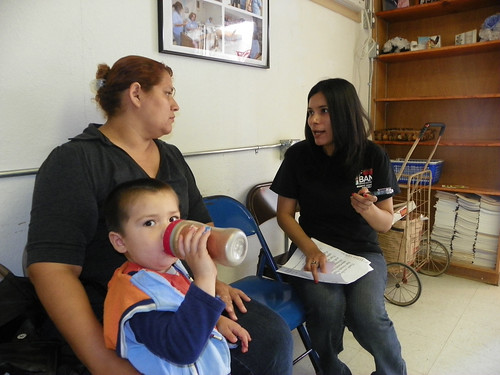Food Banks across the country help millions of families in need keep their kitchen cabinets from going empty. Much of the food given out comes from donations; however USDA’s Temporary Emergency Food Assistance Program, or TEFAP, helps food banks stretch their donations by making USDA commodity foods available to local agencies. Those State agencies distribute the food to aid organizations like food banks who serve the public whether directly or via partners like churches.
This is just the dynamic in south San Antonio, Texas where low income families benefit from the strong long term partnership between the San Antonio Food Bank and South San Filadelfia Baptist Church. The food bank supplies the church’s pantry—an integral part of getting food to families that need it the most.

The church pantry is run by a spritely 84 year old named Lois Angel who has spent nearly two decades feeding families in San Antonio’s most impoverished neighborhoods and trying to live up to her surname. Angel started the food bank when her son passed away. She used the money he left her to create the pantry as a way of continuing his legacy of religious service.
“This is my life’s work,” said Angel, who believes that retiring would only diminish her health so she continues to get up early each weekday to run the pantry. “I grew up during the great depression. I’ve seen poverty. My parents taught me that we need to help our neighbors in times of need.”
Since 1995, South San Filadelfia Baptist Church has partnered with the San Antonio Food Bank to stock the pantry Angel created and to help provide resources for people to access food. Angel, who still drives her own vehicle, visits the food bank every month to load up on supplies.
In turn, the food bank sends personnel to the church to help folks fill out paper work to get access to crucial health and nutrition services. A worker from the Texas Health and Human Services Commission visits monthly to help qualify folks on the spot for the Supplemental Nutrition Assistance Program which is especially important to what Angel calls a “growing” elderly client base in the area.

When USDA Director of Faith Based and Neighborhood Partnerships Max Finberg and USDA FNS Southwest Regional Administrator Bill Ludwig visited South San Filadelfia Church on April 13, they noted that nearly half of the people in the waiting room of the pantry were above the age of 50. Finberg and Ludwig praised Angel and her staff and encouraged them to continue their important work.
The church and food bank are contributing significantly to USDA’s efforts to reach underserved populations like Latinos and the elderly. Their success is well-documented. Last year, the church’s pantry serviced 8,000 people from its small little annex on the church property with only about a dozen employees who are mostly volunteers.
